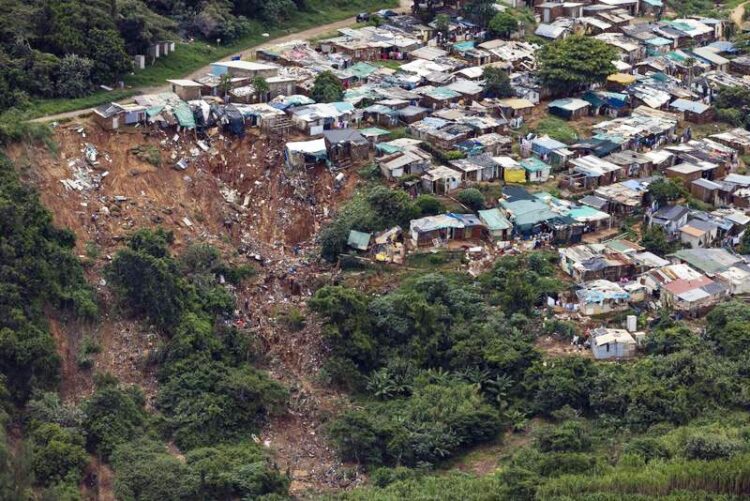Landslides increasingly threaten the world’s urban poor

A landslide in the Durban area of South Africa, triggered by the April 2022 rainfall event.
Credit: Kierran Allen
In a comment recently published in “Nature”, Dr. Ugur Öztürk and his colleagues at the University of Potsdam, the University of Bristol and the Potsdam Institute for Climate Impact Research claim that more settlements will suffer from landslides in the future as climate change and urban sprawl are destabilizing slopes in the tropics.
Over the last fifty years, disasters caused by landslides and floods have become ten times more frequent, despite landslides being significantly underreported in global databases. Worldwide, 4500 people are killed on average each year already, and landslide risk is set to escalate even further in the future under two increasing trends – climate change and urbanization. More than 80% of fatal landslides occur in the tropics, mainly triggered by heavy rainfall during cyclones and monsoons.
The rapid pace of urbanization in many tropical countries, especially low and lower-middle-income nations, will put more people in the path of landslides. “Human modifications to hillslides make them more likely to fail” says Dr. Ugur Öztürk, civil engineer and leading author of the manuscript. “Cutting into hillslopes, for terracing or to make space for houses, makes them steeper and thus more unstable. Removing plant cover and adding water through poor drainage or leaking pipes also make landslides more likely. So does mining and construction of infrastructure such as roads.”
Current landslide risk assessment approaches based on correlations found in historical data are insufficient where landslide records are poor or even missing, as common in many low and lower-middle-income countries. Quantifying the interactions between the natural environment, changing rainfall patterns, and informal urbanization is increasingly possible thanks to advances in remote sensing, data gathering and modelling. The study combined data and models of urban landslides and climate change to identify likely future hotspots of landslide risk in five representative cities across the tropics: Freetown in Sierra Leone, Antipolo and Baguio in the Philippines, Port au Prince in Haiti, and Bukavu in the Democratic Republic of Congo.
Prof. Thorsten Wagener, a co-author of the study, states: “Urbanization and climate change push the poorest into harm’s way. We currently have a window of opportunity to act before this risk increases significantly. The path we propose enables researchers, policymakers and landslide practitioners to come together to identify hot spots early and to devise policies that can prevent the worst.”
Link to Publication: Analysis: Landslides increasingly threaten the world’s urban poor, by Ugur Ozturk, Elisa Bozzolan, Elizabeth A. Holcombe, Roopam Shukla, Francesca Pianosi & Thorsten Wagener, Nature 2022, https://www.nature.com/articles/d41586-022-02141-9
Image: A landslide in the Durban area of South Africa, triggered by the April 2022 rainfall event. Image Credit: Kierran Allen.
Contact:
Dr. Ugur Öztürk, Institute of Environmental Science and Geography and Helmholtz-Centre Potsdam –
German Research Centre for Geosciences
Tel.: +49 331 977 223232
E-Mail: ugur.oeztuerk@uni-potsdam.de
Media Information 10-08-2022 / Nr. 089
Dr. Stefanie Mikulla
Universität Potsdam
Referat Presse- und Öffentlichkeitsarbeit
Am Neuen Palais 10
14469 Potsdam
Tel.: +49 331 977-1474
Fax: +49 331 977-1130
E-Mail: presse@uni-potsdam.de
Internet: www.uni-potsdam.de/presse
Wissenschaftliche Ansprechpartner:
Dr. Ugur Öztürk, Institute of Environmental Science and Geography and Helmholtz-Centre Potsdam –
German Research Centre for Geosciences
Tel.: +49 331 977 223232
E-Mail: ugur.oeztuerk@uni-potsdam.de
Media Contact
All latest news from the category: Earth Sciences
Earth Sciences (also referred to as Geosciences), which deals with basic issues surrounding our planet, plays a vital role in the area of energy and raw materials supply.
Earth Sciences comprises subjects such as geology, geography, geological informatics, paleontology, mineralogy, petrography, crystallography, geophysics, geodesy, glaciology, cartography, photogrammetry, meteorology and seismology, early-warning systems, earthquake research and polar research.
Newest articles

NASA: Mystery of life’s handedness deepens
The mystery of why life uses molecules with specific orientations has deepened with a NASA-funded discovery that RNA — a key molecule thought to have potentially held the instructions for…

What are the effects of historic lithium mining on water quality?
Study reveals low levels of common contaminants but high levels of other elements in waters associated with an abandoned lithium mine. Lithium ore and mining waste from a historic lithium…

Quantum-inspired design boosts efficiency of heat-to-electricity conversion
Rice engineers take unconventional route to improving thermophotovoltaic systems. Researchers at Rice University have found a new way to improve a key element of thermophotovoltaic (TPV) systems, which convert heat…



